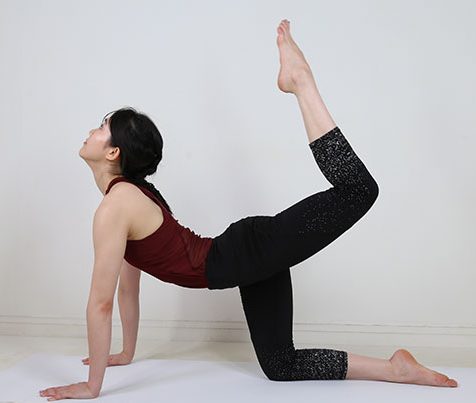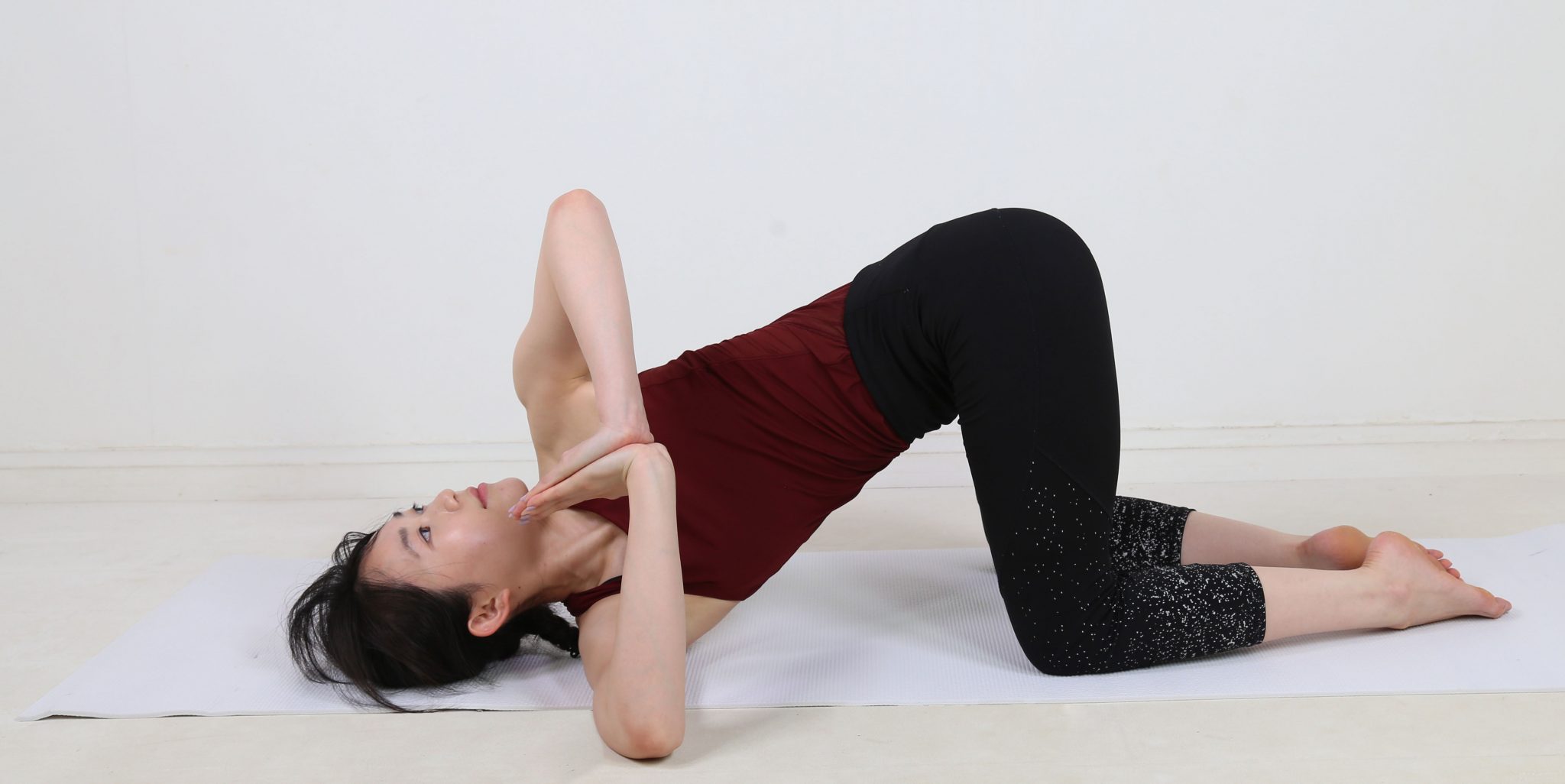By Louise Vas, with the guidance of Yogananth Andiappan Poses demonstrated by Kammy Tsang
This month’s featured pose is Uthana Vyaghrasa, an advanced variation of Vyaghrasana or Tiger Pose. In this pose, mobility of the joints and flexibility of the muscles are tested. As this pose is demanding on the whole body, proper attention and regulated breathing must be given to achieve the pose.

WARM-Up
The below warm-up poses focus on extension of the spine and improving the mobility in the shoulders. 
Bitilasana / Cow pose
1. Come to knees and hands with the back flat, hands directly below the shoulders and fingers pointing forwards (neutral position).
2. Inhale and on exhale, raise the right arm, bring the chin up and gradually arch the back. Feel the movement of the hip when moving into the arch.
3. Keep the gaze upwards and hold the pose with normal breathing.
4. Release the pose and repeat with the left arm.

Nirakunjasana / Heart Pose
1. Come into tabletop position with the hands and feet on the floor. The arms are directly under the shoulders, knees hip-width apart and the feet in line with the knees.
2. Inhale and on exhale, lean forward and slide the hands forward to bring the chest and chin to the floor. Let the weight of the body rest on the chest area and ensure that there is not too much pressure on the neck and jaw.
3. Keep the abdomen and hip away from the floor and maintain light breaths.
4. Hold the pose for a few counts. To come out of the pose, slide the knees back and lie prone on the floor.

Matsyasana / Fish Pose variation – use of blocks
1. Sit on the floor and stack two blocks, one flat and the other upright. Place the blocks about 6 inches away from the hips.
2. Place the hands behind the hips and lifting the chest to arch the back, slowly lower the torso and aim for the middle back to rest on the block. Make sure that the blocks are below the shoulder blades. Make small adjustments as needed.
3. When the arch is settled, raise the arms over the head and hold the opposite elbow. Keep the legs straight and flex the ankles to extend the calf muscles.
4. Hold the pose for a few light breaths. To come out of the pose, bring one elbow on the floor by the side of the body, and slowly roll over to the same side.
Eligibility Pose
Practice the below to have a better understanding of the muscles involved in the final pose.

Eeka Hasta Vyaghrasana / One-handed Tiger Pose
With the hands and knees on the floor and the back in its neutral shape, lift and straighten the left leg above hip level, pointing the toes. Shift the body weight to the left hand and the right arm reaches up and back to hold the left ankle. When the grip is set, the left knee pushes upwards to raise the leg. Raise the chin and look up. Hold for a few regular breaths; bring the left
STEPS

1. Start in tabletop position with the hands and knees on the floor.

2. Bend the left knee and raise the leg.

3. With the right hand’s palm facing up, reach back to hold the arch of the foot.

4. Bend the right elbow and swivel the right elbow outwards, bringing the foot closer to the head.

5. Bring the upper arm close to the face, the elbow pointing forwards.

6. Engage the left thigh and bring the right leg higher.
Final Pose

Inhale an on exhale, push the knee and aim to straighten the leg as much as possible, while the right arm extends and keeps the grip on the foot.
VARIATIONS
There are many ways an asana can be performed or interpreted depending on each practitioner, and classic Hatha Yoga text suggests that there are over 8 million poses.
Here are three variations which can provide similar benefits to the practitioner as with the final pose.

From Step 5, bring the foot to touch the top of the head and hold the pose.

A second variation would be to balance on one knee – raise the foot off the floor and keep the balance. Squeeze the bottom leg to bend the knee more.

Keep the neck extended and aim to touch the toes to the top of the head. Press the bottom foot to the floor and keep the whole body active.
Modifications
The below modifications are available:

For those with limited shoulder rotation
Wrap a strap around the foot and practice coming into the pose. Using a strap extends the reach of the arm.

For those with limited hip and hamstring extension
Practice the pose against a wall, facing away from it with heels pressing. Extend one leg upwards and aim for the thigh to be closer to the wall. Keep the arms engaged to keep the arch.

For those with limited quadriceps extension/back bending ability
Practicing against the wall, press and bend the knee, aiming to touch the foot to the top of the head. Press the palms to the floor.
Neutralizing Movments
Neutralizing movements are important for long-term injury prevention; it allows the body to return to its neutral position. Be aware of pressure alert points and listen to your body – do neutralizing movements after slowly coming out of the pose.

Balasana / Child’s Pose
From Vajrasana or Diamond pose, separate the knees and bring the body into a forward bend, extending the arms in front. As gravity works, let the chest and forehead or chin rest on the floor and the whole body relax into the pose. Stay for a few breaths and release the pose.

Kneeling Twist variation /“Thread-the-needle”
Come down to the floor on the hands and knees. Separate the knees and bring the feet together. Slide the right arm under the left and aim to bring the right shoulder and back of the head to the floor, ideally in line with the left knee. With the right shoulder pressing against the floor, press both hands together, thumbs next to the chest. Raise the left elbow, keep the chest open and not caving in. Hold the twist with a few light breaths. Come out of the pose by releasing the hands and pushing the body back up. Repeat on the other side.
Counter pose
The below counter pose helps in relieving any tension created in the spine from the backward bending.

Seated Back Expansion and Shoulder Protraction
Sit in Vajrasana with the back straight and hold the knees. Inhale and on exhale, push the chest back into a hunch and bring the chin to the chest. Round the back and pull the abdomen in to hunch the back more. Stay for a few breaths and release the pose. Repeat for two more times; gaze upwards and keep the neck neutral.
When practicing a backward bending pose like this, bring the awareness to the middle of the chest and feel the energy from the Anahata Chakra or heart centre expanding into the whole body. A positive feeling runs through the body whenever we open the heart to our teachers, classmates or the environment. Like a flower waiting for the sun to shine its rays, let us be more excited and willing to receive energy from others, and exert out best effort to turn any circumstance into a positive one.
In any physical, mental or spiritual practice like yoga, the important thing is to leave judgment at the door. When we allow the mind and body to bend, we are averting it from being broken.
Practice this pose with the guidance of an experienced teacher and enjoy every minute of it.


















 Other
Other